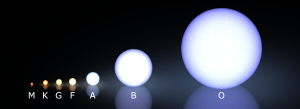Post
Color Scheme
18 March 2013
 Wikipedia
WikipediaYesterday I talked about why you never see green stars. Despite that sad fact, the color of a star is an important aspect of categorizing stars into types.
Early categorization of stars was by apparent visual magnitude. The brightest stars in the sky were magnitude 1, the next brightest magnitude 2 and so on. Typically this divided stars into six groups, so that a magnitude 6 star was just bright enough to be seen with the naked eye on a dark clear night. The color of some bright stars could be seen with the naked eye, for example in the constellation Orion Betelgeuse is reddish, and Rigel is bluish. But it’s hard to make out the colors of most stars, as they generally just look white to our limited eyes, so stars weren’t initially categorized by color.
By the late 1800s, astronomers were able to look at the spectrum of light from the stars. This meant they could look at the absorption lines of of atoms in the photosphere of a star. Since each type of atom or molecule has a particular pattern (kind of an atomic fingerprint), we could identify what types of atoms were in a particular star. So astronomers started categorizing stars into spectral types A, B, C, etc.
By the 1900s, physicists gave us an understanding of the relationship between the color of light a star gives off and its temperature. Because stars are relatively hot, they are essentially blackbody radiators. Just as iron glows red as it heats up, then gets more yellow as it gets hotter, the coolest stars (with surface temperatures of about 2 000 K) glow dim red, while higher temperature stars glow orange, yellow, white and blue.
Using photographic methods, astronomers were able to measure the brightest color, and therefore the temperature of stars. They found that their original spectral classification depended largely on the temperature of a star, so they changed to a categorization based on surface temperature (or color), resulting in the categories we have now of M, K, G, F, A, B, and O. The coolest stars being M, and the hottest stars being O. As measurements became more precise, each temperature category was divided into tenths and assigned by a number. So an F3 star has a temperature 3/10 of the way between an F0 and A0 star.
While this temperature based color scheme was useful it didn’t take into account how stars can be radically different types of stars but still have the same surface temperature. For example, Barnard’s Star is an M3 star with a mass of only 15% of the Sun, and a radius about 1/5 of our Sun’s. Betelgeuse on the other hand is an M2 star with ten times the mass of our Sun and about 1 000 times bigger radius. Barnard’s Star is a red dwarf, while Betelgeuse is a Red supergiant. So stars were then further characterized by their luminosity (actual brightness). Since Betelgeuse is a very bright star for its color, it is category I, while Barnard’s star is fairly dim, so it is category V. Most stars are category V, since this is the category of stars in their stable period, known as the main sequence. You can see a comparison of main sequence stars in the figure above.
Our Sun is a G2V star, meaning it is a main-sequence star on the cooler end of the G class. If you look at the image below, you might think that our Sun is a rather small star. While there are certainly much larger stars than the Sun, and even much larger than O type main sequence stars, that’s a little bit misleading. More than 3/4 of main sequence stars are M class stars. Only about 8% of main sequence stars are G class, so our Sun is larger than about 90% of all main sequence stars in our galaxy. Expressed in that way, our star is relatively large.
The fact that M class stars are most common is part of the reason the majority of the extrasolar planets we find are around these red dwarf stars. But, that’s a story for another time.